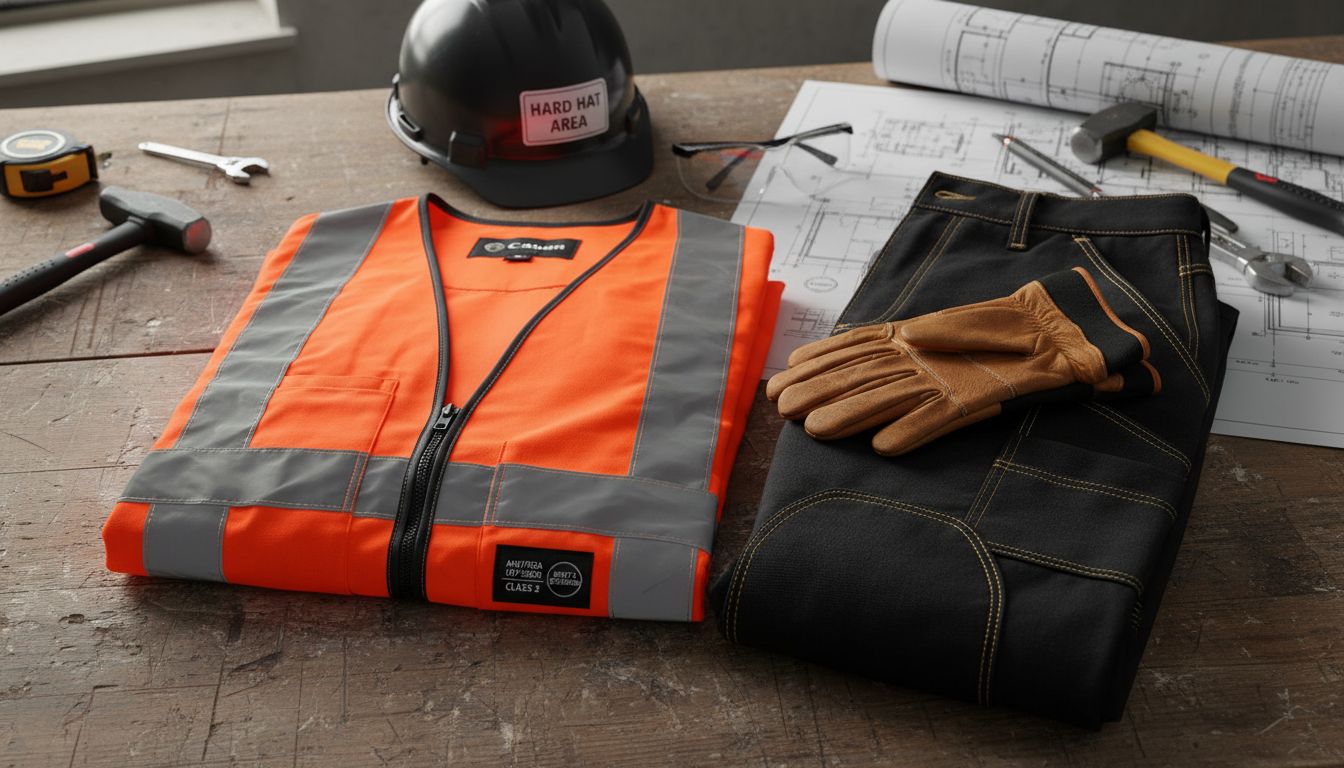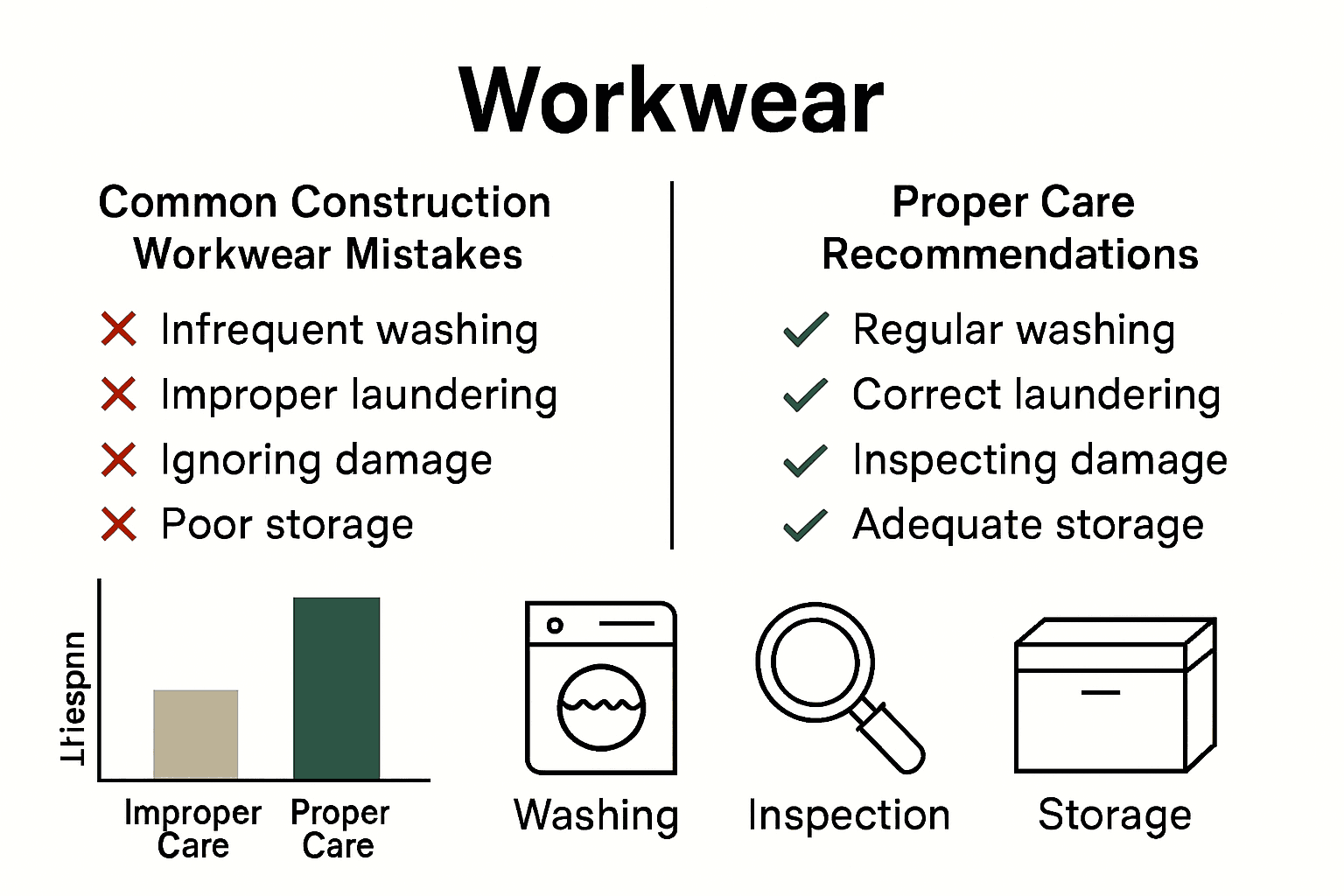Every construction worker knows that a good shirt or pair of pants can be the difference between a safe day and a serious injury. More than 2.8 million workplace injuries occur each year in the US, making what you wear on the job much more than a simple style choice. Construction clothes for men are carefully engineered to withstand tough conditions and keep workers protected, comfortable, and productive. Understanding how to choose and care for this gear sets the foundation for safety and performance on every job site.
Table of Contents
- Defining Construction Clothes For Men
- Major Types Of Men’s Construction Apparel
- Must-Have Features And Safety Standards
- How To Choose The Right Workwear
- Common Mistakes And Care Recommendations
Key Takeaways
| Point | Details |
|---|---|
| Durability, Safety, and Functionality | Construction clothing is designed as protective gear to ensure safety, unrestricted movement, and comfort in demanding work environments. |
| Key Apparel Categories | Essential construction apparel includes work shirts, pants, outerwear, and safety accessories, each serving a specific purpose for worker protection. |
| Must-Have Features | prioritize high-visibility materials, reinforced stress points, and moisture-wicking technologies to enhance safety and performance in the field. |
| Maintenance is Critical | Proper care and regular inspections of workwear are essential to maintain their effectiveness and ensure ongoing safety compliance. |
Defining Construction Clothes for Men
Construction clothes aren’t just attire - they’re your daily armor against demanding work environments. Work clothing for men in trades and construction represents a specialized category of apparel designed to protect, perform, and withstand extreme conditions. According to Y12, proper work clothing requires minimum safety standards including durable, full-length shirts and pants crafted from natural fibers.
At its core, construction clothing prioritizes three critical elements: durability, safety, and functionality. These aren’t just fancy shirts and pants - they’re engineered performance gear built to handle everything from scorching job sites to physically intense labor. The right construction clothes shield you from potential workplace hazards while providing unrestricted movement and comfort. As Carhartt’s history demonstrates, workwear has evolved from basic protective layers to sophisticated, purpose-built apparel.
Key characteristics of exceptional construction clothes for men include:
- Reinforced stress points to prevent premature wear
- High-visibility color options for enhanced safety
- Moisture-wicking fabrics that regulate body temperature
- Multiple utility pockets for convenient tool storage

- Robust materials like heavyweight cotton and canvas
- Flexibility in design to accommodate dynamic physical work
Ultimately, construction clothes represent more than clothing - they’re an investment in your professional performance, personal safety, and daily comfort. When chosen thoughtfully, these garments become your reliable companion through challenging work environments, ensuring you’re prepared for whatever the job demands.
Major Types of Men’s Construction Apparel
Construction apparel for men encompasses a diverse range of specialized garments designed to meet the rigorous demands of physical work environments. These aren’t just clothes - they’re sophisticated performance gear engineered to protect, support, and enhance worker productivity. From heavyweight work shirts to durable pants and essential safety accessories, each piece plays a critical role in workplace protection and comfort.
The primary categories of men’s construction apparel include:
Work Shirts
- Long-sleeve heavyweight cotton shirts
- Flannel and canvas button-up options
- High-visibility safety shirts
- Thermal and moisture-wicking base layers
Work Pants
- Carpenter-style utility pants
- Cargo work pants with reinforced knees
- Durable canvas and denim work trousers
- Flame-resistant and high-visibility work pants
Outerwear
- Insulated winter work jackets
- Waterproof and windproof shells
- Heavyweight canvas work coats
- Reflective safety jackets
Safety Accessories
- Hard hats and head protection
- Steel-toed work boots
- Heavy-duty work gloves
- Safety glasses and protective eyewear
Each clothing type serves a specific purpose beyond basic coverage. Work shirts protect against sun and abrasion, pants provide mobility and tool storage, outerwear shields from environmental conditions, and accessories mitigate potential workplace hazards. For those seeking comprehensive guidance on selecting the right construction apparel, our construction clothes guide offers in-depth insights into making smart wardrobe choices for tough work environments.
The evolution of construction apparel reflects ongoing technological advancements and a deeper understanding of worker safety and comfort. Modern construction clothes combine advanced materials, ergonomic design, and safety features to create garments that are not just protective gear, but essential tools for professional performance.
Must-Have Features and Safety Standards
Construction clothing isn’t just about looking professional - it’s about staying safe and protected in challenging work environments. Safety standards are the backbone of effective workwear, ensuring that every piece of clothing serves as a critical line of defense against potential workplace hazards. According to NDLTAP, high-visibility safety apparel must meet specific ANSI/ISEA 107-2015 standards, with garments carefully labeled to indicate their type and performance class.
Key safety features that every construction professional should prioritize include:
-
Visibility Elements
- Reflective strips and bright color zones
- High-contrast color combinations
- Day and night visibility options
-
Material Protection
- Flame-resistant fabrics
- Tear and abrasion-resistant materials
- Chemical and liquid-repellent coatings
International standards play a crucial role in defining workwear safety. ISO 20471 provides comprehensive specifications for high-visibility clothing, establishing rigorous design and testing methods that ensure garments offer appropriate protection in diverse work environments. These standards aren’t just bureaucratic checkboxes - they’re carefully crafted guidelines that directly impact worker safety and survival.
Beyond standardized requirements, construction clothing must also deliver functional performance. This means incorporating features like reinforced stress points, moisture-wicking technologies, ergonomic designs, and strategic ventilation. The goal isn’t just compliance - it’s creating apparel that actively supports workers’ comfort, mobility, and protection throughout demanding workdays.
Ultimately, choosing the right construction clothes is about understanding that what you wear isn’t just clothing - it’s personal protective equipment that can mean the difference between walking away from a job site safely or facing unnecessary risk. For professionals committed to their craft and personal safety, investing in high-quality, standards-compliant workwear isn’t an expense - it’s an essential investment in professional survival.
How to Choose the Right Workwear
Choosing the right workwear is more than a fashion decision - it’s a critical safety and performance strategy for construction professionals. According to ForConstructionPros, selecting appropriate high-visibility workwear requires understanding specific ANSI classifications and ensuring garments meet the required class for your specific work environment.
Key Selection Criteria for Construction Workwear:
-
Job Site Requirements
- Specific safety standard compliance
- Environmental conditions
- Potential hazard levels
-
Personal Comfort Factors
- Moisture-wicking capabilities
- Range of motion
- Temperature regulation
-
Durability Considerations
- Material strength
- Reinforced stress points
- Resistance to wear and tear
According to Education Resources, the ANSI/ISEA 107-2004 standard provides comprehensive guidelines for safety apparel, categorizing garments into performance classes based on worker hazards, job site complexity, and traffic speed. This means your workwear selection isn’t just about looking good - it’s about creating a personalized safety system tailored to your specific work environment.
Professional tip: Don’t compromise on quality. Cheap workwear might save money upfront, but it can cost you in reduced protection, shorter lifespan, and potential workplace risks. Invest in gear that offers a balance of safety features, comfort, and durability. For those looking to dive deeper into workwear selection, check out our guide on blue-collar worker apparel for more comprehensive insights.
Remember, the right workwear is your first line of defense. It’s not just clothing - it’s professional armor that protects your body, enhances your performance, and reflects your commitment to safety and excellence in your craft.
Common Mistakes and Care Recommendations
Construction workwear demands more than just purchasing the right gear - it requires consistent maintenance and smart usage to ensure ongoing safety and performance. GIS Resources emphasize that worn, stained, or damaged garments are unacceptable, and following manufacturer care instructions is critical to maintaining apparel effectiveness and safety compliance.
Common Workwear Mistakes to Avoid:
- Ignoring manufacturer washing instructions
- Using harsh chemicals or bleach
- Storing wet or damp clothing
- Continuing to wear damaged safety gear
- Overlooking regular inspection and replacement
- Mixing personal and professional workwear
Proper Care Recommendations:
- Wash high-visibility clothing separately
- Use mild detergents designed for specialized fabrics
- Air dry or use low-heat settings
- Inspect for tears, loose threads, or fading
- Replace garments showing significant wear
- Store in cool, dry areas away from direct sunlight
According to WorkZone Safety Media, maintaining high-visibility safety apparel requires keeping garments clean and in good condition to ensure maximum visibility and protection. This means treating your workwear as an essential piece of safety equipment, not just another set of clothes.
Remember, your workwear is an investment in your professional safety. Treating it with care isn’t just about extending its lifespan - it’s about maintaining your first line of defense on the job. Proper maintenance can mean the difference between being seen and being overlooked in potentially dangerous work environments.

Gear Up with Workwear Designed for the Demands of Construction
The challenges of construction work require apparel that stands up to tough conditions while keeping you safe and comfortable. This guide highlights the importance of durability, safety, and functionality—core principles that define quality construction clothes. If you’re seeking gear that protects and performs on the job site, WorkWearComfort.com has your back with rugged clothing built for blue-collar professionals.
Ready to experience gear built for hard work? Explore our Heavy Equipment Operator Hoodie Sweatshirt designed for strength and comfort in demanding environments. Pair your outfit with the perfect fit from our Blue-Collar Dad Hats collection for added style and sun protection.

Don’t wait until your workwear lets you down. Visit WorkWearComfort.com now to invest in dependable apparel that meets your safety needs and keeps you comfortable all day long. Equip yourself with gear that reflects your resilience and commitment to quality workmanship.
Frequently Asked Questions
What are the essential features to look for in construction clothes for men?
Key features to look for include durability, safety elements like high-visibility colors and reflective strips, moisture-wicking fabrics, reinforced stress points, and multiple utility pockets for convenient tool storage.
How do I choose the right type of workwear for my job site?
Consider specific job site requirements, including safety standards, environmental conditions, and potential hazards. Also, prioritize personal comfort factors like moisture-wicking capabilities and range of motion, along with the durability of materials.
What types of construction attire are most commonly used by men in the industry?
Common types of construction attire include long-sleeve work shirts, cargo work pants, insulated outerwear, and various safety accessories like hard hats and steel-toed boots.
How should I care for my construction clothes to maintain their effectiveness?
Follow manufacturer care instructions carefully, wash high-visibility clothing separately using mild detergents, inspect for damage regularly, and avoid using harsh chemicals or bleach to extend the lifespan of your workwear.


